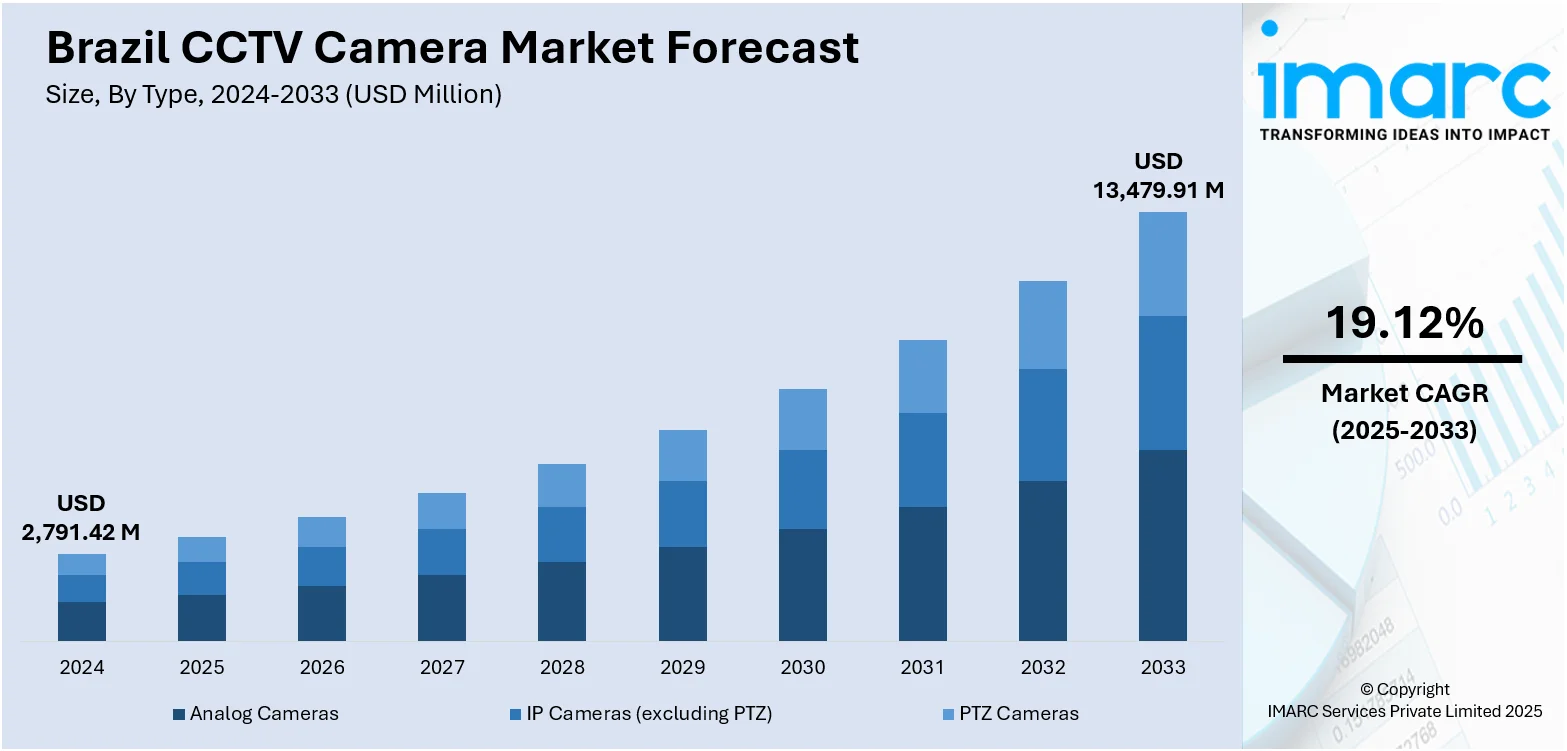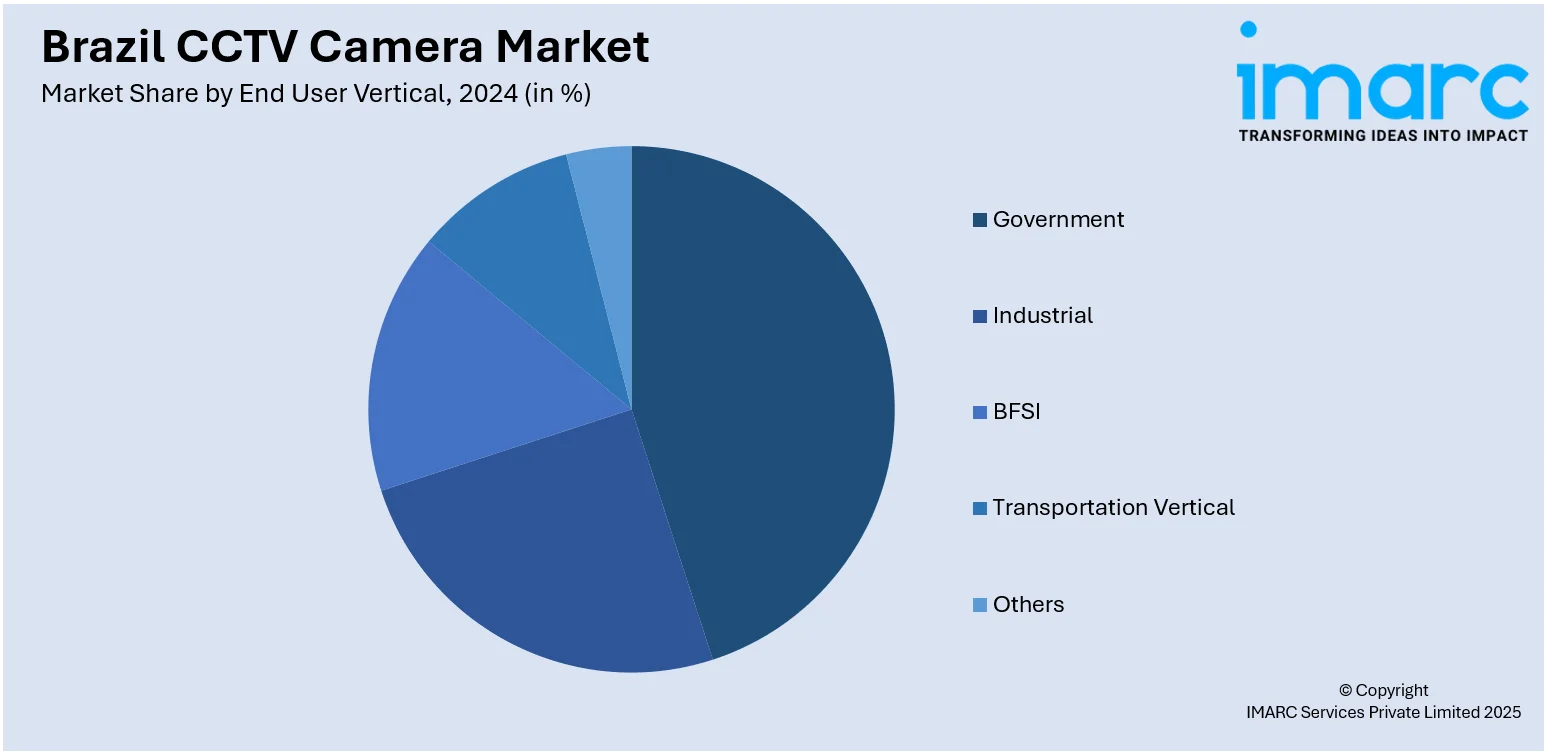
Brazil CCTV Camera Market Size, Share, Trends and Forecast by Type, End User Vertical, and Region, 2025-2033
Brazil CCTV Camera Market Overview:
The Brazil CCTV camera market size reached USD 2,791.42 Million in 2024. Looking forward, the market is projected to reach USD 13,479.91 Million by 2033, exhibiting a growth rate (CAGR) of 19.12% during 2025-2033. The market is expanding steadily, driven by growing public safety concerns, infrastructure development, and urban surveillance initiatives. Adoption of high-definition IP cameras and AI-driven analytics is rapidly increasing across sectors such as retail, banking, and transportation. Government and private enterprises are investing in smart security systems to enhance real-time monitoring and incident response. The shift toward cloud-based storage and remote access solutions is enhancing flexibility and scalability, contributing to the consistent rise in Brazil CCTV camera market share.
|
Report Attribute
|
Key Statistics
|
|---|---|
|
Base Year
|
2024
|
|
Forecast Years
|
2025-2033
|
|
Historical Years
|
2019-2024
|
| Market Size in 2024 | USD 2,791.42 Million |
| Market Forecast in 2033 | USD 13,479.91 Million |
| Market Growth Rate 2025-2033 | 19.12% |
Brazil CCTV Camera Market Trends:
AI-Driven Video Analytics Accelerating Intelligent Surveillance
The application of AI-driven video analytics is revolutionizing the CCTV camera market in Brazil, leading to more advanced and responsive surveillance systems. Modern CCTV cameras that incorporate artificial intelligence can execute real-time object detection, facial recognition, crowd density analysis, and monitoring of behavioral patterns. For instance, in December 2024, Vivotek announced its plans to enhance security in Maringá, Brazil, deploying advanced cameras with facial and license plate recognition to bolster public safety. The initiative, launched in partnership with Alca Network and Allnet, has led to a significant drop in crime rates, reinforcing Maringá’s reputation as a leading smart city in the country. These features greatly improve situational awareness, facilitating proactive threat identification and quicker decision-making in both public and private settings. Urban authorities are relying more on AI-enabled cameras for functions such as traffic management, crime deterrence, and crowd control, while businesses deploy them for analyzing customer behavior, managing access, and ensuring safety. This transition towards intelligent surveillance also contributes to optimizing human resources by diminishing the need for continuous manual observation. As AI technology becomes increasingly cost-effective and accessible, its uptake is projected to grow across various sectors, significantly contributing to Brazil CCTV camera market growth.

To get more information on this market, Request Sample
Urban and Public Infrastructure Surveillance Strengthening Safety Measures
Municipalities throughout Brazil are increasingly investing in CCTV camera systems to enhance urban safety and infrastructure management. These systems are being strategically implemented in high-traffic areas, public transit terminals, governmental buildings, and other essential sites to boost real-time visibility and response capabilities. For instance, in August 2023, Rio de Janeiro announced its plans to implement a new video surveillance system with an investment exceeding USD 17.5 Million. This project involves acquiring cameras equipped with facial recognition and license plate reading technology to enhance public safety. Installation will begin in key areas, improving monitoring effectiveness across the metropolitan region. Surveillance cameras help monitor traffic patterns, identify accidents, and ensure adherence to road regulations, which contributes to minimizing congestion and improving commuter safety. In densely populated public spaces, CCTV facilitates effective crowd control and the early identification of suspicious activities, assisting law enforcement and emergency services in upholding public order. Furthermore, the incorporation of video analytics allows for automated notifications and faster response times, rendering urban surveillance more effective and dependable. This widespread adoption of CCTV in public infrastructure is crucial for enhancing city management and public security, which also bolsters the growth of Brazil’s CCTV camera market.
Brazil CCTV Camera Market Segmentation:
IMARC Group provides an analysis of the key trends in each segment of the market, along with forecasts at the country and regional levels for 2025-2033. Our report has categorized the market based on type and end user vertical.
Type Insights:
- Analog Cameras
- IP Cameras (excluding PTZ)
- PTZ Cameras
The report has provided a detailed breakup and analysis of the market based on the type. This includes analog cameras, IP cameras (excluding PTZ), and PTZ cameras.
End User Vertical Insights:

- Government
- Industrial
- BFSI
- Transportation Vertical
- Others
A detailed breakup and analysis of the market based on the end user vertical have also been provided in the report. This includes government, industrial, BFSI, transportation vertical, and others.
Regional Insights:
- Southeast
- South
- Northeast
- North
- Central-West
The report has also provided a comprehensive analysis of all the major regional markets, which include Southeast, South, Northeast, North, and Central-West.
Competitive Landscape:
The market research report has also provided a comprehensive analysis of the competitive landscape. Competitive analysis such as market structure, key player positioning, top winning strategies, competitive dashboard, and company evaluation quadrant has been covered in the report. Also, detailed profiles of all major companies have been provided.
Brazil CCTV Camera Market News:
- In March 2025, VIVOTEK's advanced AI-powered security system enhanced surveillance at Brazil's Imperial Museum, protecting its valuable artifacts, including Dom Pedro II’s crown. The upgrade includes AI-driven cameras and a centralized management platform, improving visitor flow management and reducing false alarms, ensuring greater safety for the museum's historic collections.
Brazil CCTV Camera Market Report Coverage:
| Report Features | Details |
|---|---|
| Base Year of the Analysis | 2024 |
| Historical Period | 2019-2024 |
| Forecast Period | 2025-2033 |
| Units | Million USD |
| Scope of the Report |
Exploration of Historical Trends and Market Outlook, Industry Catalysts and Challenges, Segment-Wise Historical and Future Market Assessment:
|
| Types Covered | Analog Cameras, IP Cameras (excluding PTZ), PTZ Cameras |
| End User Verticals Covered | Government, Industrial, BFSI, Transportation Vertical, Others |
| Regions Covered | Southeast, South, Northeast, North, Central-West |
| Customization Scope | 10% Free Customization |
| Post-Sale Analyst Support | 10-12 Weeks |
| Delivery Format | PDF and Excel through Email (We can also provide the editable version of the report in PPT/Word format on special request) |
Key Questions Answered in This Report:
- How has the Brazil CCTV camera market performed so far and how will it perform in the coming years?
- What is the breakup of the Brazil CCTV camera market on the basis of type?
- What is the breakup of the Brazil CCTV camera market on the basis of end user vertical?
- What is the breakup of the Brazil CCTV camera market on the basis of region?
- What are the various stages in the value chain of the Brazil CCTV camera market?
- What are the key driving factors and challenges in the Brazil CCTV camera market?
- What is the structure of the Brazil CCTV camera market and who are the key players?
- What is the degree of competition in the Brazil CCTV camera market?
Key Benefits for Stakeholders:
- IMARC’s industry report offers a comprehensive quantitative analysis of various market segments, historical and current market trends, market forecasts, and dynamics of the Brazil CCTV camera market from 2019-2033.
- The research report provides the latest information on the market drivers, challenges, and opportunities in the Brazil CCTV camera market.
- Porter's five forces analysis assist stakeholders in assessing the impact of new entrants, competitive rivalry, supplier power, buyer power, and the threat of substitution. It helps stakeholders to analyze the level of competition within the Brazil CCTV camera industry and its attractiveness.
- Competitive landscape allows stakeholders to understand their competitive environment and provides an insight into the current positions of key players in the market.
Need more help?
- Speak to our experienced analysts for insights on the current market scenarios.
- Include additional segments and countries to customize the report as per your requirement.
- Gain an unparalleled competitive advantage in your domain by understanding how to utilize the report and positively impacting your operations and revenue.
- For further assistance, please connect with our analysts.
 Request Customization
Request Customization
 Speak to an Analyst
Speak to an Analyst
 Request Brochure
Request Brochure
 Inquire Before Buying
Inquire Before Buying




.webp)




.webp)












